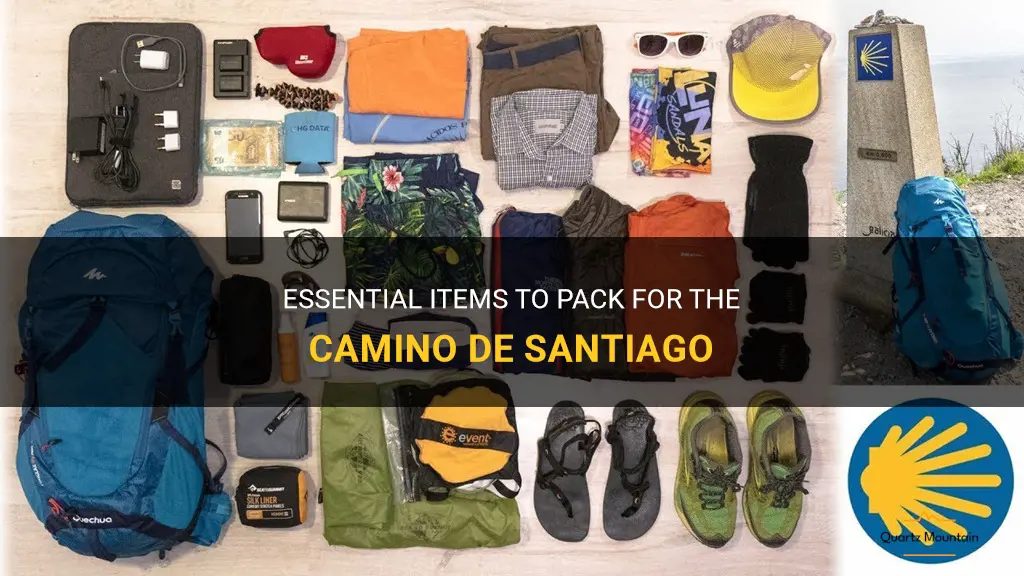
The Camino de Santiago is a popular pilgrimage route in Spain that attracts thousands of hikers from around the world every year. Whether you are planning to walk the entire 500-mile trail or just a portion of it, one thing is certain: packing the right essentials is crucial for a successful and enjoyable journey. In this guide, we will explore the must-have items that every pilgrim should pack for the Camino de Santiago, ensuring that you are prepared for whatever challenges may come your way on this epic adventure.
| Characteristic | Value |
|---|---|
| Clothing | Comfortable, lightweight, moisture-wicking, quick-drying |
| Footwear | Sturdy hiking boots, well-fitting socks |
| Backpack | 20-30 liters capacity, adjustable straps, hip belt |
| Sleeping bag | Lightweight, compact, suitable for the season |
| Rain gear | Waterproof jacket and pants |
| Walking sticks | Adjustable, lightweight |
| Water bottle | Reusable, durable |
| Toiletries | Travel-sized shampoo, soap, toothbrush, toothpaste, sunscreen |
| First aid kit | Bandages, antiseptic ointment, pain relievers |
| Maps and guidebooks | Detailed maps, guidebooks with information on accommodations |
| Money and documents | Passport, ID, pilgrim passport, cash, credit/debit card |
| Snacks | Nuts, dried fruit, energy bars |
| Electronics | Phone, charger, power bank |
| Miscellaneous | Sunglasses, hat, travel towel, earplugs, travel pillow |
What You'll Learn
- What are the essential items to pack for the Camino de Santiago?
- How many changes of clothes should I pack for the Camino de Santiago?
- Is it necessary to bring a sleeping bag or can I rely on hostels and albergues along the way?
- What kind of footwear is recommended for the Camino de Santiago?
- Are there any specific items or gear that are often overlooked but important to pack for the Camino de Santiago?

What are the essential items to pack for the Camino de Santiago?
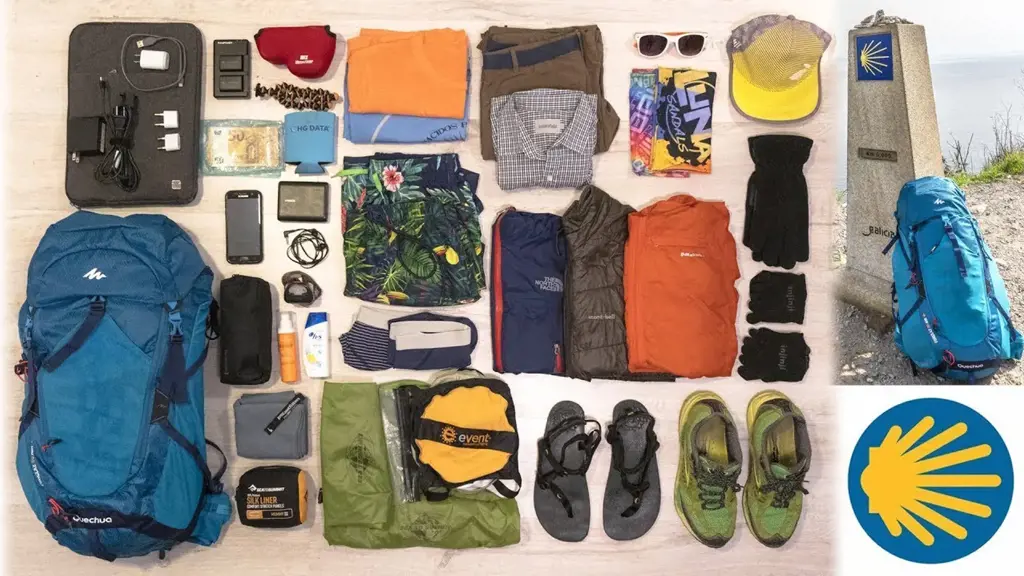
The Camino de Santiago, also known as the Way of St. James, is a popular pilgrimage route that stretches across Spain to the city of Santiago de Compostela. This historic trail attracts thousands of hikers and pilgrims each year, all seeking a unique spiritual and cultural experience. If you're planning to embark on this extraordinary journey, it's essential to pack the right items to ensure a comfortable and successful trek.
Here are some essential items you should consider packing for the Camino de Santiago:
The Right Footwear:
A sturdy and comfortable pair of hiking boots or trail running shoes are a must for the Camino. Make sure you've broken them in before your trip to avoid blisters and discomfort. It's important to find shoes that provide good ankle support and have a durable sole to withstand the varied terrain along the route.
Backpack:
Invest in a lightweight, waterproof backpack with a capacity of around 30-40 liters. This will allow you to carry all your essential items without weighing you down. Look for a backpack with adjustable straps and sufficient compartments to keep your belongings organized.
Clothing:
Pack lightweight and moisture-wicking clothing for the hike. Opt for quick-drying fabrics instead of cotton to help regulate your body temperature and avoid chafing. You'll need a few sets of comfortable hiking socks, a long-sleeved shirt, pants, and a rain jacket for protection against the elements. Don't forget a wide-brimmed hat and a buff or bandana to protect your face from the sun.
Sleeping Bag and Pad:
Most accommodations along the Camino will provide bedding, but it's always a good idea to have your own sleeping bag and pad for extra comfort and hygiene. Choose a lightweight sleeping bag suitable for the expected weather conditions and a compact sleeping pad for insulation and cushioning.
Toiletries:
Keep your hygiene in check by packing a travel-sized toiletry kit that includes a toothbrush, toothpaste, soap, and a towel. You may also want to bring a small bottle of hand sanitizer, toilet paper, and wet wipes for convenience.
First Aid Kit:
It's crucial to have a basic first aid kit with you in case of any minor injuries or ailments. Include essentials like adhesive bandages, pain relief medication, blister treatment, antiseptic ointment, and any necessary prescription medications. Familiarize yourself with how to use each item and make sure they are easily accessible in your backpack.
Navigation:
Even though the Camino de Santiago is well-marked, having a navigation system can be helpful, especially if you plan to explore alternate routes. Consider bringing a compass, a detailed map or guidebook, and a reliable GPS device or smartphone app to ensure you stay on track.
Money and Documents:
Don't forget to pack your identification documents, including your passport, as you may need them for check-ins or emergencies. Carry some cash in both the local currency and your own currency, as not all establishments along the Camino accept cards. It's also a good idea to have a copy of your travel insurance policy and important contact numbers stored electronically.
Snacks and Water Bottle:
Fuel your body with energy-boosting snacks like nuts, dried fruit, energy bars, or trail mix. These portable snacks will come in handy when you're trekking between towns or during longer stretches without food options. Additionally, bring a refillable water bottle to stay hydrated throughout the day. There are numerous fountains and water sources along the Camino where you can refill your bottle.
Miscellaneous Items:
There are a few miscellaneous items that can enhance your Camino experience. Consider packing a lightweight and quick-drying travel towel, a headlamp or flashlight, a pocket knife, a clothesline with clips for drying your laundry, and a small sewing kit for any unexpected clothing repairs.
Remember to pack your backpack strategically, placing heavier items closer to your back to distribute the weight evenly. It's always a good idea to practice carrying your loaded backpack before your trip to ensure you're comfortable with the weight and to make any necessary adjustments.
The Camino de Santiago can be a life-changing adventure, and having the right essentials will make your journey more enjoyable and fulfilling. As you plan your trip, consider these essential items to ensure you have a memorable and successful pilgrimage. Buen Camino!
Essential Items to Include in Your Packing List for a Pigeon Forge Trip
You may want to see also

How many changes of clothes should I pack for the Camino de Santiago?
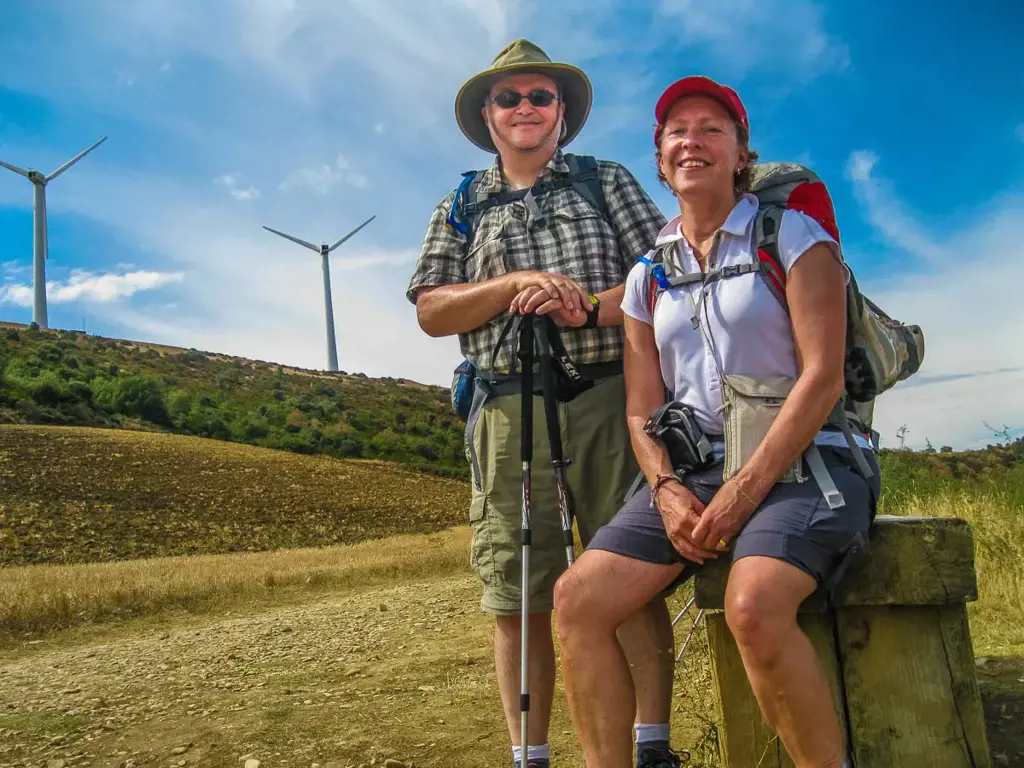
When preparing for the Camino de Santiago, it's important to pack light and only bring the essentials. One common question that pilgrims often ask is how many changes of clothes they should pack for this long-distance hiking trail. The answer to this question depends on a few factors, including the length of your journey, the time of year you are hiking, and your personal preferences.
If you are planning to complete the entire Camino de Santiago, which can take anywhere from 30 to 40 days, it's recommended to pack enough clothes for about a week. This allows you to have clean clothes to wear while washing and drying the rest. However, if you are only planning to hike a specific section of the trail, you can adjust the number of clothes accordingly.
The time of year you are hiking also plays a role in determining how many changes of clothes you should pack. If you are hiking during the warmer months, such as spring or summer, you may sweat more and need to change clothes more frequently. In this case, it's a good idea to bring a couple of extra t-shirts and underwear. On the other hand, if you are hiking during the cooler months, such as fall or winter, you may not need to change clothes as often, as you won't sweat as much.
It's important to consider the weight and space limitations of your backpack when deciding how many changes of clothes to bring. Remember, the lighter your backpack, the more enjoyable your hike will be. Packing unnecessary clothes can add unnecessary weight, so be mindful of what you really need.
To give you a general idea, here is a sample list of clothes you can pack for the Camino de Santiago:
- Two t-shirts: one to wear and one as a spare.
- Two pairs of hiking pants or shorts: one to wear and one as a spare.
- One long-sleeve shirt or light sweater for cooler evenings.
- Three pairs of underwear: one to wear, one as a spare, and one being washed and dried.
- Three pairs of socks: one to wear, one as a spare, and one being washed and dried.
- One lightweight rain jacket or poncho.
- One hat or cap for sun protection.
- One pair of sandals or flip-flops for relaxing in the evenings.
- One pair of comfortable walking shoes.
Keep in mind that this list is just a suggestion, and you should adjust it according to your specific needs and preferences. Additionally, many pilgrims find it helpful to pack clothes that can be easily layered, allowing them to adjust to different weather conditions. Layering allows you to add or remove clothing as needed, keeping you comfortable throughout your journey.
Ultimately, the number of changes of clothes you should pack for the Camino de Santiago will depend on your personal circumstances and preferences. It's important to strike a balance between having enough clean clothes and keeping your backpack light. By packing smart and bringing the essentials, you can ensure a more enjoyable and comfortable pilgrimage on the Camino de Santiago.
The Essential Wardrobe: What Clothes to Pack for an MSC Cruise
You may want to see also

Is it necessary to bring a sleeping bag or can I rely on hostels and albergues along the way?
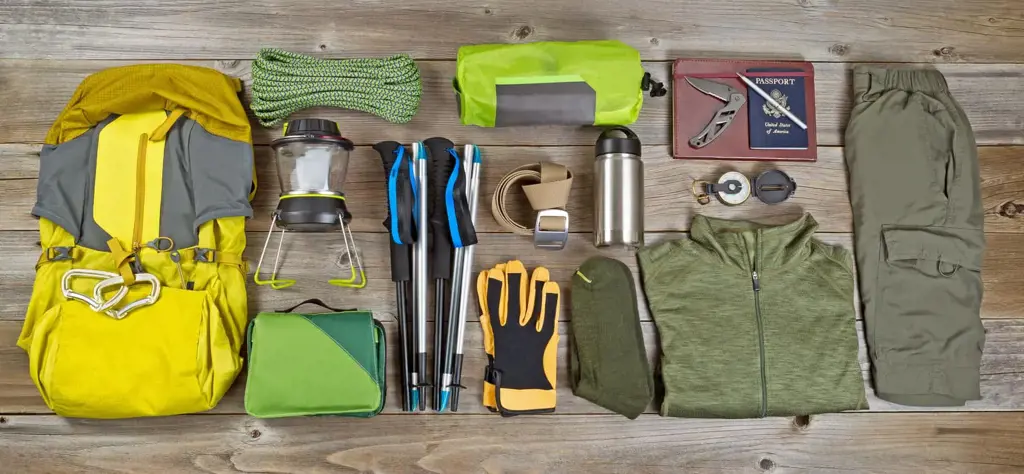
When embarking on a long-distance hike, such as the Camino de Santiago pilgrimage, one of the essential items to consider bringing is a sleeping bag. However, many people wonder if it is necessary to bring their own sleeping bag or if they can rely on hostels and albergues along the way. In this article, we will explore the benefits of bringing a sleeping bag and when it may be possible to rely on accommodations.
One of the main reasons why bringing a sleeping bag is advised is the unpredictability of the available accommodations along the trail. While there are numerous hostels and albergues along the Camino de Santiago route, it is impossible to predict their availability or the quality of their bedding. Some accommodations may have limited space or be fully booked, leaving pilgrims without a place to sleep. In such situations, having your own sleeping bag ensures that you always have a comfortable place to rest for the night.
Moreover, even when accommodations are available, the bedding provided may not be up to everyone's standards. Some albergues might provide thin or worn-out blankets, while others may not provide any bedding at all. In these cases, having a sleeping bag can guarantee that you have a cozy and clean place to sleep, regardless of the quality of the provided bedding.
Additionally, a sleeping bag can provide a sense of independence and flexibility. With a sleeping bag, you are not solely reliant on finding hostels or albergues along the way. This allows you to have more flexibility in choosing your resting spots and can open up opportunities to camp outdoors or take advantage of other unique accommodations that may not provide bedding, such as monasteries or churches.
However, there are situations where it may be possible to rely on the accommodations provided along the Camino de Santiago. The availability of hostels and albergues is generally good, especially during the peak pilgrimage season. If you are traveling during a less crowded time or on a less popular route, it is more likely that you will find available accommodations along the way.
It is also worth noting that even when accommodations are available, they may be limited in terms of space. Some albergues operate on a first-come, first-served basis, and if you arrive late or during a busy period, you might find yourself without a bed. In these cases, having a sleeping bag can be a lifesaver, as you can simply find a spot to lay down and sleep comfortably, without worrying about the availability of beds or overcrowded dormitories.
In conclusion, while it is possible to rely on hostels and albergues along the Camino de Santiago route, it is highly recommended to bring a sleeping bag for added comfort, flexibility, and peace of mind. A sleeping bag ensures that you always have a place to sleep, regardless of the availability or quality of accommodations along the way. It provides a sense of independence and allows you to make the most of your pilgrimage by being able to rest anywhere comfortably. So, before embarking on your journey, be sure to pack a reliable and lightweight sleeping bag to guarantee a restful experience on the Camino.
Essential Packing Materials for a Smooth Move: A Guide
You may want to see also

What kind of footwear is recommended for the Camino de Santiago?
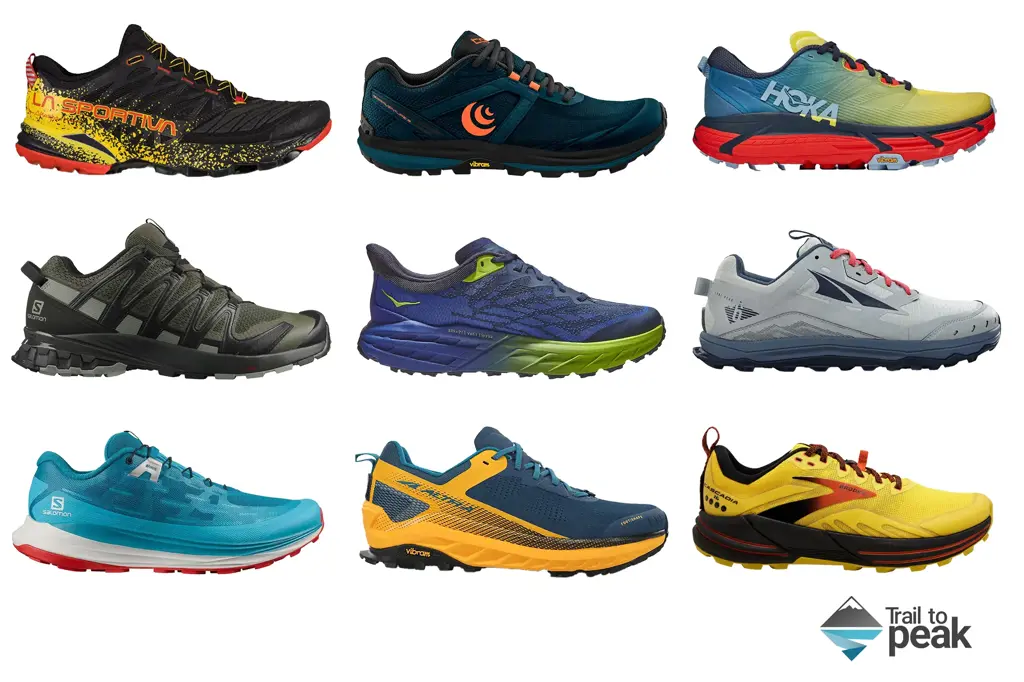
When embarking on the Camino de Santiago, it is important to have the right footwear to ensure a comfortable and successful journey. The Camino de Santiago is a long-distance pilgrimage route that spans across Spain and attracts thousands of hikers and walkers each year. The type of footwear recommended for this journey can vary depending on individual preferences and needs, but there are a few key factors to consider when choosing the right shoes for this adventure.
First and foremost, it is crucial to invest in a pair of shoes that provide ample support and cushioning. The Camino de Santiago involves long hours of walking or hiking, often on varied terrain, so having shoes that can absorb shock and provide stability is essential. Look for shoes with a thick, flexible sole that can protect your feet from the impact of each step and provide proper arch support.
In addition to support and cushioning, it is also important to consider the weight and breathability of your footwear. As you will be walking for long periods of time, you want shoes that are lightweight and breathable to avoid discomfort and blisters. Look for shoes made from breathable materials such as mesh or synthetic materials that allow for air circulation and keep your feet dry.
Another factor to consider is the durability and traction of the shoes. The Camino de Santiago includes various terrains, including rocky paths, gravel, and dirt trails. Having shoes with good traction and a durable outsole will help you navigate these terrains with ease and prevent slips or falls. Look for shoes with a rubber outsole that provides good grip and has deep treads for better traction.
When it comes to sizing, it is recommended to go for a slightly larger size than what you normally wear. This is because your feet tend to swell while walking long distances, and having some extra room in your shoes will prevent discomfort and blisters. It is also advisable to break in your shoes before embarking on the Camino de Santiago. Wear them for a few shorter hikes or walks to allow them to mold to your feet and ensure a proper fit.
Lastly, it is essential to consider personal preferences and comfort when choosing footwear for the Camino de Santiago. Some people prefer hiking boots for the added ankle support and protection, while others find lightweight trail running shoes to be more comfortable. Try on different styles and brands to find the one that suits you best and provides the right balance of support, comfort, and durability.
In conclusion, choosing the right footwear for the Camino de Santiago is crucial for a comfortable and successful journey. Opt for shoes that provide ample support and cushioning, are lightweight and breathable, have good traction and durability, and fit properly. Finding the perfect pair of shoes will help you enjoy the breathtaking scenery and cultural experience without the discomfort of foot pain or blisters.
Packing Essentials for a Memorable Backpacking Adventure in Morocco
You may want to see also

Are there any specific items or gear that are often overlooked but important to pack for the Camino de Santiago?
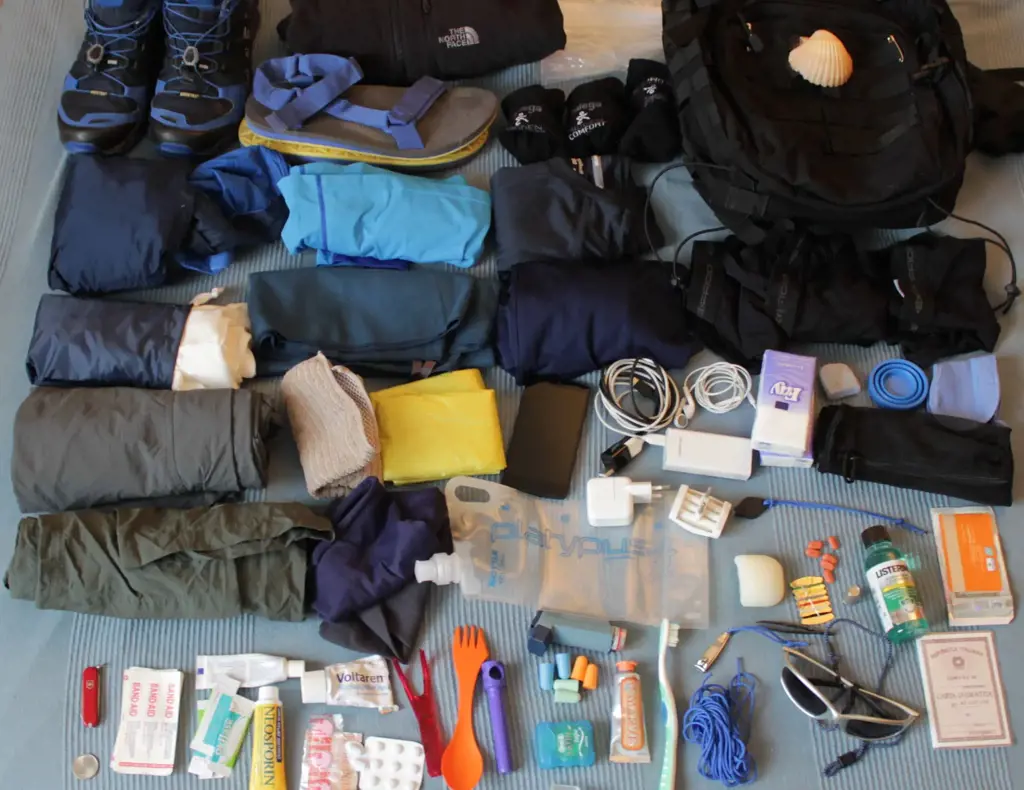
The Camino de Santiago, a famous pilgrimage route in Spain, attracts thousands of walkers and hikers every year. While many people are aware of the basic essentials to bring on such a journey – sturdy walking shoes, a comfortable backpack, and suitable clothing – there are a few often overlooked items that can greatly enhance the experience and make the journey more enjoyable.
First and foremost, a high-quality, lightweight sleeping bag is crucial for a comfortable night's rest. The albergues, or pilgrim hostels, along the Camino generally provide beds, but rarely offer bedding. Having a sleeping bag ensures that you can create your own clean and cozy sleeping environment, regardless of the conditions in the hostel.
Another important item that is often forgotten is a reusable water bottle or hydration pack. Staying hydrated is essential while walking long distances, especially during the hotter months. Many towns and villages along the Camino have public water fountains where you can refill your bottle, saving you money and reducing your plastic waste.
A lightweight towel is also a handy item to have. While some albergues provide towels, they are often small and thin. Bringing your own quick-drying towel allows you to comfortably dry off after a shower without having to rely on the hostel's limited resources.
In addition to these essentials, there are a few other items that can greatly enhance your Camino experience. A comfortable and supportive pair of sandals or flip-flops is a must-have for relaxing your feet at the end of a long day of walking. They also come in handy for showering in communal bathrooms. A small first aid kit with band-aids, blister pads, and pain relievers is also a smart addition to your packing list. While medical facilities are available along the Camino, it's always better to be prepared for minor injuries or discomfort.
Furthermore, it's worth considering packing a lightweight camping stove and cookware if you plan on cooking your own meals. While most towns and villages offer restaurants and cafes, having the ability to cook your own food can save you money and provide more options for meals, especially if you have dietary restrictions or preferences.
Lastly, don't forget to bring a power bank or portable charger for your electronics. While many albergues have outlets to charge your devices, they can be scarce or in high demand. Having a portable charger ensures that you can recharge your phone or camera whenever needed, allowing you to capture and share your Camino experience without worry.
In conclusion, while the basic essentials are important, there are a few often overlooked items that can greatly enhance the experience of walking the Camino de Santiago. A high-quality sleeping bag, reusable water bottle, lightweight towel, comfortable sandals or flip-flops, a small first aid kit, a camping stove and cookware, and a power bank for electronics are all items that should be considered when packing for this famous pilgrimage route. By being prepared and bringing these often overlooked items, you can ensure a more comfortable and enjoyable Camino experience.
The Ultimate Packing Guide for an All-Inclusive Resort Vacation in Cancun
You may want to see also
Frequently asked questions
When packing for the Camino de Santiago, it's important to pack lightweight, moisture-wicking clothing that can easily be layered. This includes items such as quick-drying shirts, pants or shorts, and a lightweight rain jacket. It's also important to pack a few changes of socks and underwear, as well as a sun hat and sunglasses for protection from the sun. Don't forget to include comfortable walking shoes or boots, and consider bringing a pair of sandals for resting your feet in the evenings.
In addition to clothing, there are a few key personal items that you should pack for the Camino de Santiago. These include a good quality backpack to carry your belongings, a sleeping bag or sleeping sack for staying in albergues or hostels, a towel, and basic toiletries such as a toothbrush, toothpaste, soap, and a small first aid kit. It's also a good idea to bring a lightweight camping towel or bandana for drying off after a shower.
The weather can vary greatly along the Camino de Santiago, so it's important to be prepared for different weather conditions. In the summer months, temperatures can be hot during the day, so it's important to bring lightweight, breathable clothing. However, the evenings and mornings can be cool, so it's a good idea to pack a lightweight fleece or sweater for layering. In the spring and fall, the weather can be more unpredictable, so it's a good idea to bring a lightweight, packable rain jacket and waterproof pants. In the winter months, the weather can be cold, especially in the mountains, so it's important to pack warm clothing, including a hat and gloves.
In addition to clothing and personal items, there are a few other essential items that you should pack for the Camino de Santiago. These include a refillable water bottle, a guidebook or map of the route, a pilgrim passport for collecting stamps along the way, a small flashlight or headlamp, a power bank for charging your electronic devices, and a money belt or secure bag for keeping your valuables safe. It's also important to pack some snacks, such as energy bars or dried fruit, for fueling your body during long stretches of walking.







